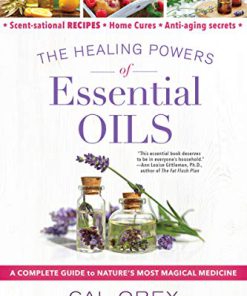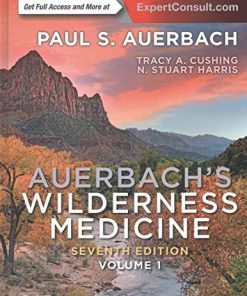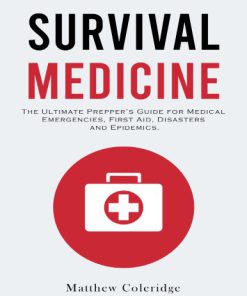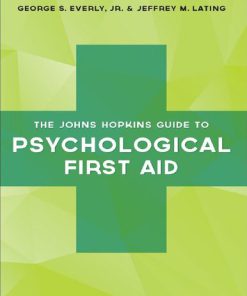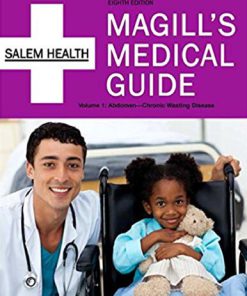Medicine for the Outdoors The Essential Guide to First Aid and Medical Emergencies 6th Edition Paul S Auerbach
$50.00 Original price was: $50.00.$25.00Current price is: $25.00.
This completed downloadable of Medicine for the Outdoors The Essential Guide to First Aid and Medical Emergencies 6th Edition Paul S Auerbach.
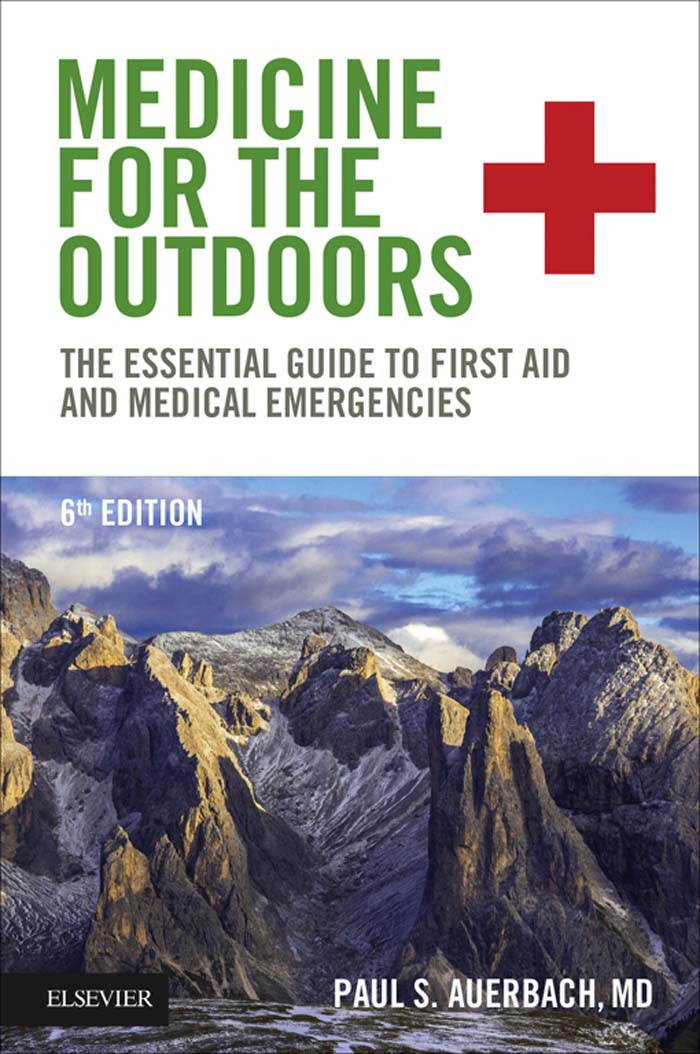
Instant downloaded Medicine for the Outdoors The Essential Guide to First Aid and Medical Emergencies 6th Edition Paul S Auerbach pdf docx epub after payment.
Product details:
- ISBN-10 : 0323341543
- ISBN-13 : 9780323341547
- Author : Paul S. Auerbach
Since 1986, Medicine for the Outdoors has been hailed as the definitive take-along manual on the subject. Packed with step-by-step instructions and how-to explanations, this updated edition tells you the best way to respond to just about any medical problem. Logically organized, simple-to-understand enhanced illustrations and an increased focus on new topics mean this medical reference book may literally save your life. Whether you’re venturing into mountains, deserts, forests, or out to sea, it belongs in your pack!
Table of contents:
Part One General Information
How to Use This Book
Before You Go
Be in Good Health
Be Prepared
Common Sense
Rules of the Road
Conditioning and Acclimatization
Equipment
Communication
Trip Plans
Medicines
Nutrition
Fluid Requirements
Personal Hygiene and Bodily Waste Disposal
General Injury Prevention: Risk Factors
Disaster Preparedness
The Scene
Duty to Assist
General First-Aid Principles
Evaluate the Victim
Assisting a Victim of Starvation
Long-Term Care of an Unconscious or Gravely Disabled Person
Medical Decision-Making
Part Two Major Medical Problems
Introduction
An Approach to the Unconscious Victim
Helmet Removal
Airway
Breathing
Check for Pulses (Circulation)
Protect the Cervical Spine
Chest Injury
Broken Ribs
Flail Chest
Pneumothorax
Bruised Lung
Treatment for Chest Injuries
Serious Lung Disorders
Asthma
Pulmonary Embolism
Heart Failure (Often Called “Congestive Heart Failure”)
Chronic Obstructive Pulmonary Disease
Pneumonia
Chest Pain
Angina Pectoris
Heart Attack (Acute Myocardial Infarction)
Very Rapid Heart Rate
Noncardiac Causes of Chest Pain
Bleeding
Treatment for Bleeding
Internal Bleeding
Shock
Head Injury
Concussion, with or without Loss of Consciousness
No Loss of Consciousness
Lacerations of the Scalp
Allergic Reaction
Treatment for an Allergic Reaction
Seizure
Treatment for Seizure
Fractures and Dislocations
Compartment Syndrome
Splints and Slings
Taping
Specific Injuries
Amputation
Burns
Definitions (Figure 117)
Treatment for Burns
Burn Prevention
Inhalation Injuries
Thermal Injury
Smoke (Chemical) Injury
Air Quality Index for Particles
Aspiration Injury
Abdominal Pain
General Evaluation
Physical Examination
Epigastrium
Right Upper Quadrant
Left Upper Quadrant
Right Lower Quadrant
Left Lower Quadrant
Lower Abdomen (Central)
Flank
Emergency Childbirth
Complicated Deliveries
Diabetes
Stroke
Infectious Diseases
Malaria
Yellow Fever
Dengue
Chikungunya Illness
West Nile Viral Disease
Eastern Equine Encephalitis
Relapsing Fever
Typhoid and Paratyphoid Fevers
Ebola, Lassa, and Other Viruses That Cause “Hemorrhagic Fevers”
Schistosomiasis
Rocky Mountain Spotted Fever
Colorado Tick Fever
Lyme Disease
Ehrlichiosis
Anaplasmosis
African Tick-Bite Fever
Babesiosis
Trichinellosis (Trichinosis)
Leptospirosis
Tularemia
Meningococcal Disease (Including Meningitis)
Rabies
Dealing with Death
Handling a Dead Body
Emotional Considerations
Obtaining Assistance
Part Three Minor Medical Problems
Introduction
General Symptoms
Unconscious (or Semiconscious) Victim
Fainting
Fatigue
Fever and Chills
Fever in a Returned Traveler
Cough
Coughing Blood
Hiccups (Hiccoughs)
Dizziness
Head (Also Eye, Ear, Nose, Throat, and Mouth)
Headache
Bell’s Palsy
Ear
Eye
Nose
Throat
Mouth and Teeth
Upper Respiratory Disorders
Common Cold
Influenza
Bronchitis
Pleuritis
Hay Fever
Disorders of the Gastrointestinal Tract
Diarrhea
Constipation
Hemorrhoids, Anal Fissure, and Rectal Prolapse
Flatus
Heartburn
Nausea and Vomiting
Vomiting Blood
Ulcer Disease
Hepatitis
Skin Disorders
Sunburn
Sunscreens
Melanoma
Poison Ivy, Sumac, and Oak (Genus Toxicodendron)
Rashes Incurred in the Water
Hives
Heat Rash
Intertrigo
Chafe
Impetigo
Cellulitis, Including Methicillin-Resistant Staphylococcus Aureus
Abscess
Ingrown Toenail
Fingertip Cracks
Paronychia
Felon
Blisters
Plantar Warts
Athlete’S Foot, Ringworm, and Jock Itch
Tinea Versicolor
Onychomycosis
Diaper Rash
Armpit Odor
Lice
Scabies
Creeping Eruption
Shingles
Herpes Simplex Virus Genital Infection
Fever Blisters
Minor Bruises and Wounds
Bruises
Black Eye
Blood under the Fingernail
Torn Fingernail
Puncture Wounds
Impaled Object
Scrapes
Cuts (Lacerations)
Skin Flaps and Avulsions
Taping a Wound Closed
Sewing (Suturing) a Wound Closed
Stapling a Wound Closed
Gluing a Wound Closed
Bandaging Techniques
Wound Infection
Abscess (Boil)
Scalp Laceration (Cut on the Head)
Fishhook Removal
Splinter Removal
Blisters
Musculoskeletal Injuries
Overuse Syndromes
Arthritis
Bursitis
Venous Thrombosis and Thrombophlebitis
Back Pain
Disorders of the Kidneys, Bladder, and Prostate
Bladder Infection
Kidney Infection
Kidney Stone
Blood in the Urine
Acute Urinary Retention
Prostate Infection
Male Genital Problems
Painful Testicle
Penile Discharge
Infection of the Foreskin (Balanitis)
Psychiatric Emergencies
Anxiety
Panic
Hyperventilation
Depression
Psychosis
Reaction to an Injury or Illness
Posttraumatic Stress Disorder
Part Four Disorders Related to Specific Environments
Injuries and Illnesses Due to Cold
Hypothermia (Lowered Body Temperature)
What to Do if You Fall Through the Ice
How to Assist Someone Who Has Fallen Through the Ice
Winter Storm Preparedness
Safe Sledding
Frostbite
Frostnip
Immersion Foot (Trench Foot)
Chilblain (Pernio)
Raynaud’S Phenomenon
Hives Induced by Exposure to Cold
Snow Blindness
Injuries and Illnesses Due to Heat
Burn Injuries
Heat-Related Illness (Hyperthermia)
Heat Exhaustion and Heatstroke
Muscle Cramps
Heat Swelling
Fainting
Avoiding Heat Illness
Wildland Fires
High-Risk Situations
Standard Fire Encounter Principles
What to Do When Caught in a Wildland Fire
How to Report a Fire
Creating a Defensible Space
Medical Considerations
Carbon Monoxide Poisoning
High Altitude–Related Problems
Prevention of High Altitude–Related Disorders
High-Altitude Pulmonary Edema
High-Altitude Cerebral Edema
Acute Mountain Sickness
Other Disorders of High Altitude
Snakebite
Poisonous Snakes
Nonpoisonous Snakes
Insect and Arthropod Bites
Bees, Spiders, Scorpions, and Other Small Biters
Spiders
Scorpions
Mosquitoes
Biting Flies
Fleas
Chiggers
Centipedes and Millipedes
Ticks
Caterpillars
Beetles
Sucking Bugs
Skin Infestation by Fly Larvae
Insect Repellents and Other Protection Against Insects
Leeches
Lightning Strike, Tornado (Cyclone), Hurricane (Typhoon), Flood, Earthquake, Tidal Wave (Tsunami), Landslide (Mudslide), Volcano, and Snow Avalanche
Lightning Strike
Lightning Avoidance and How to Seek Safety
Tornado Avoidance and How to Seek Safety
Hurricane: How to Seek Safety
Flood: How to Seek Safety
Earthquake: What to Do and How to Seek Safety
Tidal Wave: How to Seek Safety
Landslide: How to Seek Safety
Volcano
Snow Avalanche
Hazardous Aquatic Life and Aquatic Infections
Sharks
Barracudas
Moray Eels
Sponges
Jellyfish
Coral and Barnacle Cuts
Sea Urchins
Starfish
Cucumbers
Bristleworms
Cone Snails (Shells)
Stingrays
Catfish
Scorpionfish
Surgeonfish
Octopuses
Sea Snakes
Skin Rashes Caused by Aquatic Plants (Seaweed Dermatitis) or Creatures (Sea Bather’s Eruption, Swimmer’s Itch)
Poisonings from Seafood
Underwater Diving Accidents
Air Embolism
Decompression Sickness (the “Bends”)
Nitrogen Narcosis
Ear Squeeze
Sinus Squeeze
Tooth Squeeze
Drowning
Recognizing a Victim of Drowning
Prevention of Drowning
Animal Attacks
General Treatment
Special Considerations
Avoidance of Hazardous Animals
Wild Plant and Mushroom Poisoning
Medical History
Treatment for Poisonings
Commonly Ingested Toxic Plants and Mushrooms
Toxicity of Common Plants
Toxic Plants by Common Name, Latin or Common Scientific Name—Type of Toxicity
Nontoxic Plants (Common Name, Latin or Common Scientific Name)
Part Five Miscellaneous Information
Oxygen Administration
Precautions
Water Disinfection
Motion Sickness
Jet Lag
First-Aid Kits
Basic Supplies
General Supplies
Wound Care: Preparations and Dressings
Splinting and Sling Material
Eye Medications and Dressings
Dental Supplies
Topical Skin Preparations
Nonprescription Medications
Prescription Medications (Select From This List, and From Information Throughout This Book, What You Feel You Might Need; the Drugs Listed are “for Example”)
Allergy Kit
Forest and Mountain Environments
Aquatic Environments
Immunizations
Tetanus
Poliovirus; Diphtheria; Pertussis (Whooping Cough); Measles, Mumps, Rubella (German Measles); Chickenpox; Haemophilus B; Rotavirus
Smallpox
Cholera
Yellow Fever
Meningococcus
Herpes Zoster
Human Papillomavirus
Hepatitis
Bubonic Plague
Rabies
Malaria
Typhoid Fever
Typhus Fever
Influenza
Pneumococcal Pneumonia
Japanese Encephalitis
Lyme Disease
Physicians Abroad
Transport of the Injured Victim
Lifting and Moving Techniques
Carries and Litters
Helicopters
Ground-to-Air Distress Signals
Lost People
Procedures
Intramuscular Injection
Subcutaneous Injection
Fishhook Removal
Splinter Removal
Ring Removal
Zipper Removal
Knots and Hitches
Appendix One Commonly Used Drugs (Medications) and Doses
Drugs and Pregnancy
Allergic Reaction to a Drug
For Relief from a Severe Allergic Reaction
For Relief from a Mild Allergic Reaction or Hay Fever
For Relief from Severe Asthma or Chronic Obstructive Pulmonary Disease
For Relief from Mild Asthma
For Treatment of Chest Pain (Angina)
For Treatment of Congestive Heart Failure
For Treatment of Seizures (Epilepsy)
For Relief from Pain (See also “For Relief from Muscle Aches or Minor Arthritis”)
For Relief from Fever
For Relief from Muscle Aches or Minor Arthritis
For Relief from Muscle Spasm
For Relief from Migraine Headache
For Relief from Itching
For Relief from Toothache
For Relief from Motion Sickness
For Relief from Nausea and Vomiting
For Relief from Diarrhea
For Relief from Constipation
For Relief from Ulcer Pain
For Relief from Indigestion or Gas Pains
For Relief from Heartburn (Reflux Esophagitis)
For Relief from Nasal Congestion
For Relief from Cough
For Relief from Sore Throat
Cold Formulas
Skin Medications
For Sleep
Antibiotics
Appendix Two Conversion Tables
Fahrenheit and Centigrade (Celsius) Temperature Conversion
Measures of Length
Measures of Volume (Capacity)
Measures of Weight
Conversion Between Feet and Meters
Appendix Three Guidelines for Prevention of Diseases Transmitted Via Human Blood and Other Bodily Fluids
Human Immunodeficiency Virus Postexposure Prophylaxis
Appendix Four Commonly Used Applications of the SAM Splint
General
The Concept: the Basic Bend
Finger Splint (for Fingertip Injuries, Broken or Dislocated Finger, Cut Finger)
Volar (Underneath) Wrist Splint (for Broken Wrist, Cut Wrist, Carpal Tunnel Syndrome)
Thumb Spica Splint (for Navicular [Scaphoid] Fracture, Broken or Dislocated Thumb, Ulnar Collateral Ligament Sprain)
Ulnar Gutter Splint (for Broken or Dislocated Fourth or Fifth Finger)
Double Layer Wrist Splint (for Sprained or Broken Wrist, Cut Wrist)
Upper Arm Splint (for Broken Upper Arm)
“Sugar Tong” Splint (for Dislocated or Broken Elbow)
Elbow Splint (for Dislocated or Broken Elbow)
Adjustable Cervical (Neck) Collar (for Suspected Neck Injury)
Anterior Dislocation of the Shoulder
Ankle Stirrup Splint (for Sprained, Broken, or Dislocated Ankle; for Broken Lower Leg)
Figure-Eight Ankle Splint (for Sprained, Broken, or Dislocated Ankle)
Combination Ankle Stirrup and Figure-of-Eight Splint (for Sprained, Broken or Dislocated Ankle Where Maximum Immobilization is Needed)
Single Long Leg Splint (for Broken Lower Leg)
Double Long Leg Splint (for Broken Lower Leg Where More Immobilization is Needed)
Knee Immobilizer Splint (for Knee Injuries)
Half-Ring Splint for Femur Fracture (for Broken Femur)
Impaled Object Protector
Appendix Five Personal Safety in an Age of Global Conflict, Kidnapping, and Terrorism
Safe Travel
Kidnapping and Hostage Behavior
Piracy
Blast Injuries
People also search:
how the outdoors helps mental health
why the outdoors is good for you
what essential oils are good for the lungs
which basic need is the most essential
what is essential safe
You may also like…
Relationships & Lifestyle - Alternative Medicine & Natural Healing
The Healing Powers of Essential Oils A Complete Guide to Nature s Magical Medicine Cal Orey
Politics & Philosophy
Medicine - Natural Medicine
Uncategorized
Medicine - Clinical Medicine




